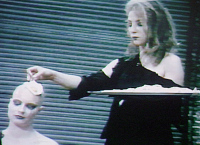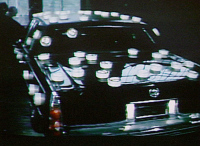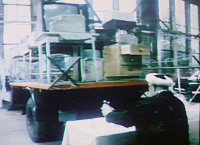


Das Frühstück des Leonardo Da Vinci, 1988
BVU, PAL, son, couleur
For almost fifty years Wolf Vostell travelled the world and recreated it, drawing a sort of imaginary map condensing languages and cultures, myths and history, video and painting, electro-acoustic music and noise music, technologies as modern as television and as artisanal as block-printing or drawing. A multimedia artist known for his dé-collages (both 'un-collages' and 'lift-offs' in French), he created a dialogue between different media, distorted them, broke aesthetic and ideological barriers. Beginning in 1962, through his participation in the Fluxus movement, he marked the beginnings of a new language, a different kind of intervention of the artist in the world. Actions and happenings/concerts were an extension of his plastic vision, a challenge to every kind of 20th century alienation. In a purely critical objective, he imposed an art of conflict, rupture, diversity, frees the image from a certain number of reference points and influences, against museums and the new media order.
This tape is itself a museum of the horrors and massacres of war, but also of contemporary society. Neither past nor present, it forms a heterogeneous space constituted of several tableaux, homages to great artists (Dalí, Picasso, Hokusai, Nam June Paik, Leonardo da Vinci), sealed-off scenes short-circuited by exterior views of Berlin. Within this polyptych, this funereal work, Vostell positions himself as a witness, an illustrator, a geometrician of this memory that recalls itself and renews itself ceaselessly in a present-day space.
The violence of the scenes, the mortification and torture of women's bodies, their piercing cries, as well as the obsessive recurrence of themes from throughout his oeuvre: coffin-cars, animals, feathers, earth, stones, blood, tools, chains… liberate in the space a self-destructive energy, a state of suffering, a scenography of cruelty.
Translated by Phoebe Green